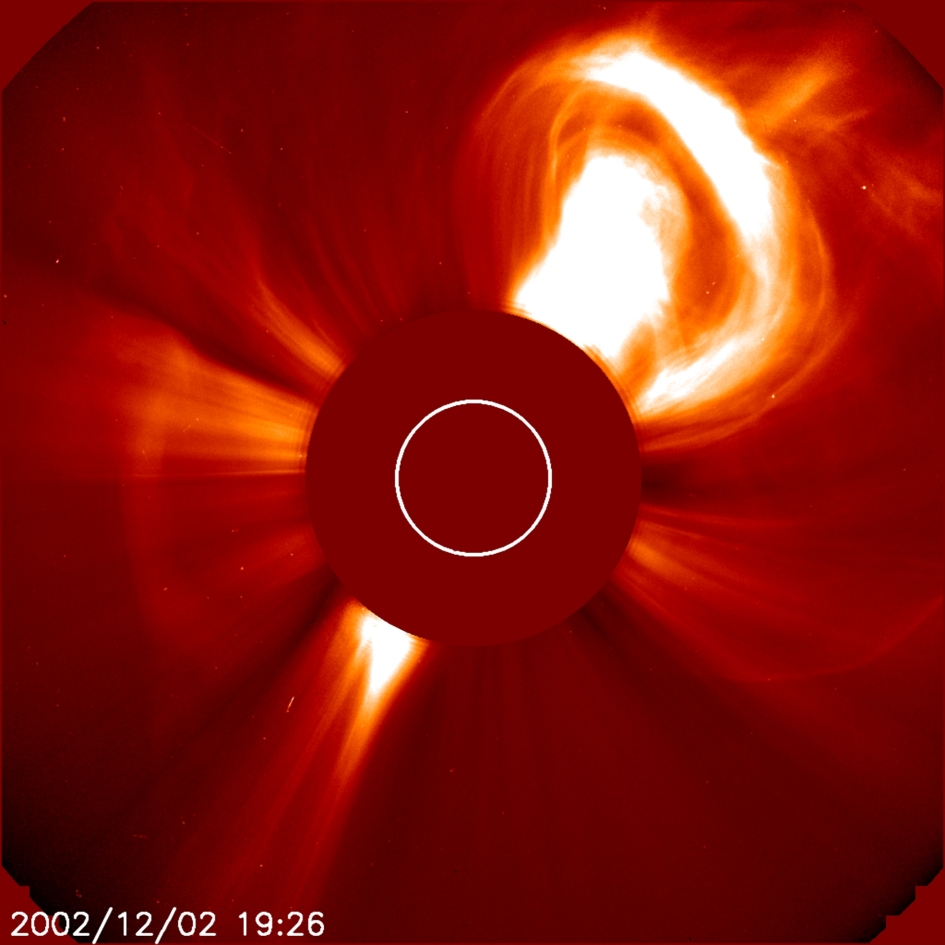The Solar Corona and inner Heliosphere
The physical Environment

|
| White light image of a CME, courtesy of SOHO/LASCO consortium. SOHO is a project of international cooperation between ESA and NASA. [click to enlarge] |
The physical region under study extends from Sun's visible "surface", the
photosphere, out to the inner planets of the Solar system.
While in former times, people had pictured this region as static and
essentially empty, science has since shown that is neither: Both theoretical
arguments
(Parker 1958)
and spacecraft measurements by Lunik I and
Mariner II (1966) have firmly established the presence of the
solar wind, a stream of dilute, ionized gas (mostly hydrogen) which
radially emanates from the Sun and fills the solar system, thereby creating
within the interstellar medium a huge bubble of gas which is termed the
heliosphere.
Since its properties vary in dependence on the state of its source, the solar
surface, the heliosphere thus connects the Sun to the planets and the
interstellar environment. Several manifestations of solar activity imprint
their signature upon the wind's structure:
- First, the photospheric energy input is transported outwards and into the corona. When released, it heats the coronal gas to temperatures of several 106 K, i.e. several orders of magnitude hotter than the photosphere itself. Although the transport and release processes have been under investigation for almost half a century, this coronal heating problem still lacks a convincing solution.
- The amount of solar activity (which shows most prominently in the average number of visible sunspots) varies periodically, with a time span of about 11 years (Schwabe cycle) between consecutive maxima. This cycle coincides with a change in the Sun's magnetic topology: During solar minimum, the global magnetic field is shaped like an axisymmetric dipole, which is stretched out radially by the solar wind and forms a current sheet in the equatorial plane. Towards the maximum, the field becomes increasingly irregular, only to re-settle into the next minimum configuration, which now has the opposite polarity (i.e. the same field line image compared to the preceeding maximum, with the direction of field vectors reversed). Another 11 years later, the Hale cycle (22 years) is completed, and the process starts anew.
- The solar rotation causes the magnetic field lines to be bent into a spiral pattern. Since the wind speed can vary with longitude, this often causes high-speed regions to collide with low-speed regions ahead of them, forming so-called corotating interaction regions (CIRs), in which shocks can built up and then accelerate particles.
- Additionally, the Sun produces huge eruptions called coronal mass ejections (CMEs), which are expelled outwards as magnetised bubbles containing some 1013 kg of solar material. These CMEs occur most frequently during solar maximum (at rates of about 1 to 3 events per day), and are often (though not always) sufficiently energetic to escape the Sun's gravity. Upon contact with a planetary magnetosphere like that of Earth, the resulting interaction can lead to beautiful aurorae, but it can also damage or even destroy satellites and related communication infrastructure. Furthermore, the associated energetic particle events can even pose hazards to astronauts. The need to predict the rise and evolution of such events, which have been popularized under the buzz word "space weather", has become very clear during the last decade, which has demonstrated the ever increasing vulnerability of modern technology to such effects.
Topics covered by the Heliophysics Group
Within this group, the study of the inner heliosphere mainly focuses on
- the outward propagation of the Sun's magnetic field by the solar wind,
- the fully three-dimensional propagation of CMEs, CIRs, and other interplanetary transients, and
- the dynamics of MHD turbulence in the expanding solar wind.
Additionally, we seek to develop and improve computational codes and methods which can be used to study this environment.
Magnetohydrodynamics
The heliospheric medium consists of almost completely ionized gas and thus
forms a plasma, which can and does interact with the Sun's large-scale
magnetic field in a very subtle and non-linear way. The theory of
magnetohydrodynamics (MHD for short) has proven a powerful tool to provide a
relatively realistic description of the corona's dynamics.
MHD treats the plasma as a compressible, conducting fluid, for which all
variables are smooth functions of space and time (except for shocks and other
discontinuities). Both the equations of MHD as well as methods of solving them
are very similar to the case of hydrodynamics (HD), except that the magnetic
vector field enters as an additional variable, resulting in a much richer set
of effects and phenomena. The main advantage of MHD is that it allows the
mutual interaction between the magnetic field and the fluid flow to be
described in a self-consistent manner. However, since a set of coupled,
non-linear partial differential equations needs to be solved in all but the
most simple cases, one is usually forced to resort to
numerical simulations
to achieve further progress.

